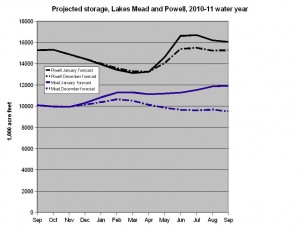What a difference a wet, wet month in the Colorado Basin makes.
In December, the long range forecasts for the big reservoirs at Lake Powell (upstream) and Lake Mead were flirting with trouble. Lake Mead’s levels for the end of the 2010-11 water year were forecast to drop to 1076.68 feet above sea level, close to the magic 1075, the level that would trigger the Colorado River’s first shortage declaration in history. But a series of December storms that brought major inflows between Powell and Mead, along with significant above-average precip across much of the rest of the basin, has changed everything.
The latest Bureau of Reclamation “24-month study” (pdf) shows substantial improvement, sufficient that there is now a 76 percent chance that water managers in the Lower Basin will hear that magic word they’ve been longing for: “equalization”. In short, equalization means that there’s enough flowing into Lake Powell in the Upper Basin that a big slug of bonus water could be released through the Grand Canyon to help raise the levels of Lake Mead.
I hope this graph will help illustrate what’s going on (click through to blow it up). The dotted lines are the early December, pre-storm projections – Mead in blue below, Powell in black. The solid lines are the current median projection, based on the latest runoff forecast from the Colorado Basin River Forecast Center. You can see that the total estimated storage in each reservoir rises under the new forecast, but that Mead rises a lot more than Powell. That’s because the river’s operating rules favor Mead under the current situation. Both reservoirs get a slug of the bonus water, but Mead gets a bigger share in a process called “equalization” – an attempt by the river’s managers to essentially balance the amount of water in storage in the two reservoirs.
It is worth remembering that the fix here requires extra water to be released from Lake Powell, above and beyond the requirements of the 1922 Colorado River Compact and related elements of the “Law of the River“. The compact and related legal structures require the release of 8.235 million acre feet per year. The new equalization forecast calls for a release of 11.36 maf, a bonus of more than 3 million acre feet. This is a reminder that the fix for the Lower Basin’s problems of a dwindling Lake Mead requires more water than the law prescribes under normal operations.


Pingback: River Beat: AZ Water May Not Need to Leave Water in Mead : jfleck at inkstain